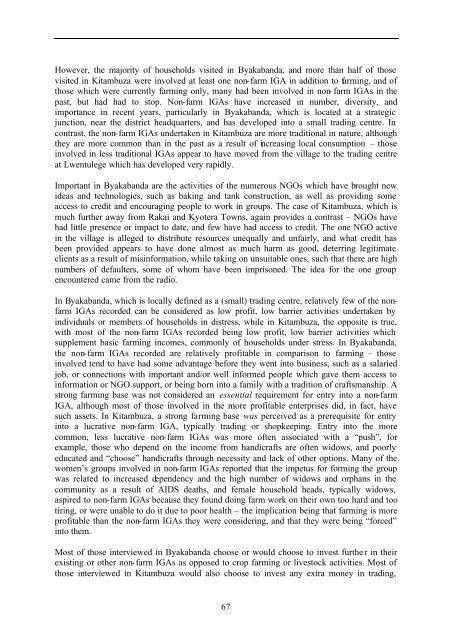Access to Rural Non-Farm Livelihoods - Natural Resources Institute
Access to Rural Non-Farm Livelihoods - Natural Resources Institute
Access to Rural Non-Farm Livelihoods - Natural Resources Institute
You also want an ePaper? Increase the reach of your titles
YUMPU automatically turns print PDFs into web optimized ePapers that Google loves.
However, the majority of households visited in Byakabanda, and more than half of those<br />
visited in Kitambuza were involved at least one non-farm IGA in addition <strong>to</strong> farming, and of<br />
those which were currently farming only, many had been involved in non-farm IGAs in the<br />
past, but had had <strong>to</strong> s<strong>to</strong>p. <strong>Non</strong>-farm IGAs have increased in number, diversity, and<br />
importance in recent years, particularly in Byakabanda, which is located at a strategic<br />
junction, near the district headquarters, and has developed in<strong>to</strong> a small trading centre. In<br />
contrast, the non-farm IGAs undertaken in Kitambuza are more traditional in nature, although<br />
they are more common than in the past as a result of increasing local consumption – those<br />
involved in less traditional IGAs appear <strong>to</strong> have moved from the village <strong>to</strong> the trading centre<br />
at Lwentulege which has developed very rapidly.<br />
Important in Byakabanda are the activities of the numerous NGOs which have brought new<br />
ideas and technologies, such as baking and tank construction, as well as providing some<br />
access <strong>to</strong> credit and encouraging people <strong>to</strong> work in groups. The case of Kitambuza, which is<br />
much further away from Rakai and Kyotera Towns, again provides a contrast – NGOs have<br />
had little presence or impact <strong>to</strong> date, and few have had access <strong>to</strong> credit. The one NGO active<br />
in the village is alleged <strong>to</strong> distribute resources unequally and unfairly, and what credit has<br />
been provided appears <strong>to</strong> have done almost as much harm as good, deterring legitimate<br />
clients as a result of misinformation, while taking on unsuitable ones, such that there are high<br />
numbers of defaulters, some of whom have been imprisoned. The idea for the one group<br />
encountered came from the radio.<br />
In Byakabanda, which is locally defined as a (small) trading centre, relatively few of the nonfarm<br />
IGAs recorded can be considered as low profit, low barrier activities undertaken by<br />
individuals or members of households in distress, while in Kitambuza, the opposite is true,<br />
with most of the non-farm IGAs recorded being low profit, low barrier activities which<br />
supplement basic farming incomes, commonly of households under stress. In Byakabanda,<br />
the non-farm IGAs recorded are relatively profitable in comparison <strong>to</strong> farming – those<br />
involved tend <strong>to</strong> have had some advantage before they went in<strong>to</strong> business, such as a salaried<br />
job, or connections with important and/or well informed people which gave them access <strong>to</strong><br />
information or NGO support, or being born in<strong>to</strong> a family with a tradition of craftsmanship. A<br />
strong farming base was not considered an essential requirement for entry in<strong>to</strong> a non-farm<br />
IGA, although most of those involved in the more profitable enterprises did, in fact, have<br />
such assets. In Kitambuza, a strong farming base was perceived as a prerequisite for entry<br />
in<strong>to</strong> a lucrative non-farm IGA, typically trading or shopkeeping. Entry in<strong>to</strong> the more<br />
common, less lucrative non-farm IGAs was more often associated with a “push”, for<br />
example, those who depend on the income from handicrafts are often widows, and poorly<br />
educated and “choose” handicrafts through necessity and lack of other options. Many of the<br />
women’s groups involved in non-farm IGAs reported that the impetus for forming the group<br />
was related <strong>to</strong> increased dependency and the high number of widows and orphans in the<br />
community as a result of AIDS deaths, and female household heads, typically widows,<br />
aspired <strong>to</strong> non-farm IGAs because they found doing farm work on their own <strong>to</strong>o hard and <strong>to</strong>o<br />
tiring, or were unable <strong>to</strong> do it due <strong>to</strong> poor health – the implication being that farming is more<br />
profitable than the non-farm IGAs they were considering, and that they were being “forced”<br />
in<strong>to</strong> them.<br />
Most of those interviewed in Byakabanda choose or would choose <strong>to</strong> invest further in their<br />
existing or other non-farm IGAs as opposed <strong>to</strong> crop farming or lives<strong>to</strong>ck activities. Most of<br />
those interviewed in Kitambuza would also choose <strong>to</strong> invest any extra money in trading,<br />
67

















